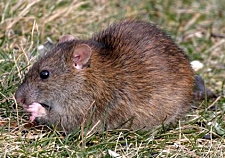Wildlife - Species

Norway Rat (Rattus novegicus)
Description
The Norway rat is a large rodent with short, coarse fur that is grayish-brown above and pale below. It weighs 280-540 grams (10-19 oz) and measures 30-50 cm (12-19 in) long including a 15-23 cm (6 -9 in) tail that is covered with scaly rings. This species is differentiated from the Eastern woodrat by its scaly tail and smaller eyes.
Preferred Habitat and Biology
The Norway rat is widespread throughout all of North America. It frequents diverse habitats such as salt marshes, wharves, garbage dumps, and sewers. However, this rat can be found anywhere it finds shelter and a food source. Since its introduction in the eighteenth century, it has spread prolifically throughout the United States.
The Norway rat is polygamous, breeds year round, and lives up to 3 years in the wild. It produces an average of seven litters per year with 7 to 11 young per litter. Gestation in this species lasts 21-23 days, after which the female gives birth to altricial young (naked and blind) who open their eyes after approximately 2 weeks. Young are weaned at 3 weeks and are ready to reproduce after approximately 4 months. Norway rats construct their nests out of rags, paper, or other suitable material. Colonies typically consist of 10 to 12 individuals with one dominant, older, larger male.
Norway rats consume almost anything organic they can find and have been known to kill poultry, birds, and rabbits. They are themselves important food for raptors, snakes, and predatory mammals.
In the late eighteenth century, Hessian troops hired to fight against the colonists in the American Revolution introduced this species to the east coast of the United States in boxes of grain brought aboard ships from Europe. The Norway rat arrived in Europe from central Asia in the sixteenth century and subsequently spread throughout the continent. This rodent derives its common name not because overly large populations of this species occur in Norway, but because Norway was where early scientific descriptions of the species originated. When local populations of the Norway rat become overcrowded, mass migrations tend to occur. This fact most likely led to the legend of the Pied Piper of Hamelin, who rid the town of rats by leading them into the Weser river to drown.
Species Significance
The Norway rat is abundant in the area. Like other rodents, Norway rats can carry diseases harmful, and even fatal, to humans such as typhoid, bubonic plague, and spotted fever. They can also be destructive to agricultural crops and property. White laboratory rats are a specially bred albino strain of the Norway rat used for scientific purposes.
References
Golley, F.B. 1966. South Carolina mammals. Charleston Museum, Charleston, SC.
Webster, W.D., J.F. Parnell, and W.C. Biggs. 1985. Mammals of the Carolinas, Virginia, and Maryland. University of North Carolina Press, Chapel Hill, NC.
Whitaker, J.O. 1980. The Audubon Society field guide to North American mammals. Alfred A. Knopf, New York, NY.
